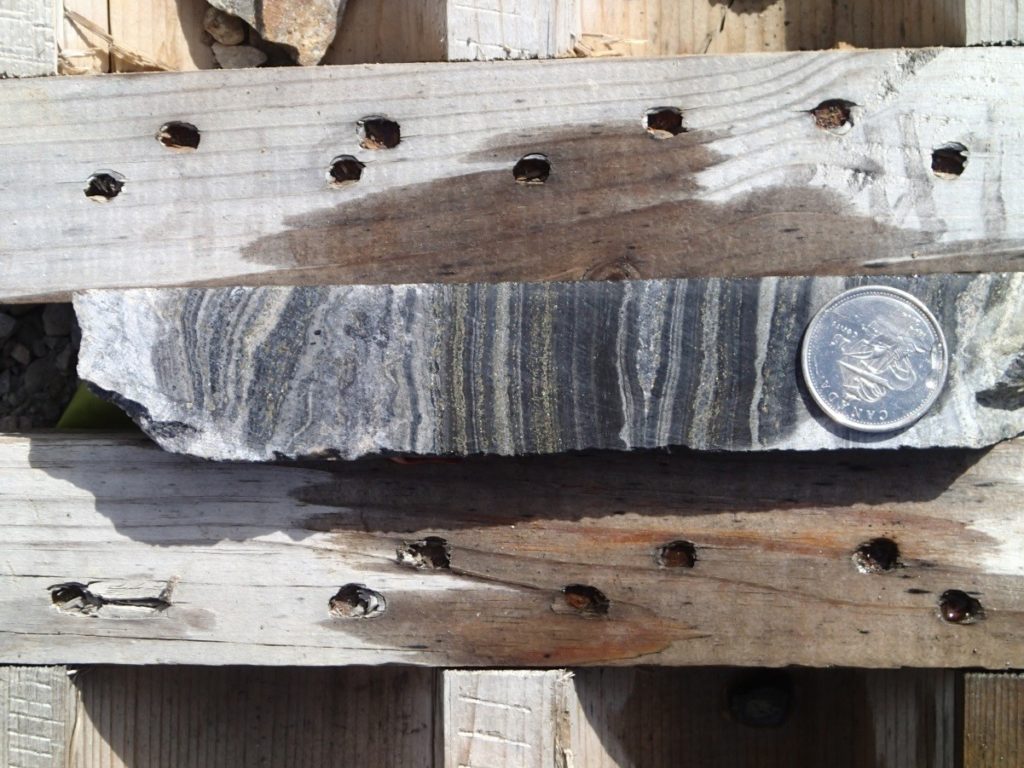Fireweed Zinc Ltd reports positive results of an independent PEA for its Macmillan Pass project in Yukon, Canada. The PEA was prepared in accordance with NI 43-101 by JDS Energy and Mining, with work on tailings and water by Knight Piesold Consulting.
The picture shows drill core from the Tom West Zone showing layers of zinc and lead rich mineralisation.
Production and Economic Highlights:
- 18-year mine life with 32.7 Mt of mineralization mined at 4,900 t/d average processing rate
- 1.54Mt of Zinc, 0.88Mt of Lead, and 37Moz of Silver in concentrate shipped
- Average yearly contained-metal production of 85,000 t Zinc, 48,000 t Lead and 2Moz Silver
- Robust economics using metals prices of $1.21/lb Zn, $0.98/lb Pb, and $16.80/oz Ag
- Pre-Tax NPV at 8% of C$779 million CAD and IRR of 32%
- After-Tax NPV at 8% of C$448 million and IRR of 24%
- Pre-production CAPEX of $404 million
- Payback period of 4 years
- Starter-pits on Tom West and Jason Main zones reduce up-front capital
- Numerous opportunities for significant economic improvement
- Known zones remain open for expansion, including into high-grade areas
- Highly prospective and large land package untested with modern exploration methods.
“This first NI43-101-compliant PEA on the Macmillan Pass Project represents a significant step as we progress towards production. Project economics in the PEA demonstrate that Macmillan Pass is not just viable at the zinc, lead and silver prices levels contemplated in the study, but highly robust,” commented Brandon Macdonald, Chief Executive Officer. “With consideration of the exploration upside not just at the known zones, but also within the broader land package, the project is steadily shaping up to be a premiere district-scale zinc mining camp in the mining-friendly Yukon Territory.”
Off-site charges include concentrate transport to Skagway for loading onto ocean-going cargo ships bound for smelter destinations yet to be determined but assumed to be in Asia. The charges also include treatment charges and penalties as shown in the table below.
This PEA is based on a mine plan for delivery of 32.66 Mt at a diluted head grade of 9.07% Zn equivalent (5.31% Zn, 3.56% Pb and 43.41g.t Ag) delivered to the processing plant.
Initial material will be recovered at a rate of about 5,000 t/d by conventional truck and shovel surface mining from both the Tom and Jason deposits. During the third year, production will transition to underground mining using Avoca-style sub-level retreat longhole stoping, vertical crater retreat (VCR) and Alimak stoping. Stopes will be filled with a combination of waste rock and paste and cemented rock fill.
Open pit mining accounts for 13% or 4.2 Mt of the total 32.7 Mt of material mined and processed. VCR and LH methods account for 75% of the material mined and processed by underground methods.
Mining recovery and dilution factors were applied by mining method. Average open pit mining recovery and dilution were 95% and 10% respectively. Average underground mining recovery and dilution were 92% and 21% respectively.
Existing surface roads and underground development will be rehabilitated and used as part of the mine plan. Mine access portals at multiple elevations are planned to maximize natural ventilation and dewatering of underground operations. Open pits have been designed to maintain safe working distance from all major water ways.
Diesel powered mobile equipment would be used to conduct all open pit and underground mining activities. Underground crushing and conveying would provide low cost mineral transport from the Tom deposit, while the Jason mine being further from the mill site would utilize truck transport.
The company reported details of metallurgical testing with excellent results in a news release dated May 15, 2018. The project incorporates a standard comminution, flotation separation flow sheet including a primary crusher feeding a single SAG mill, thence a ball mill, followed by selective two and three-stage flotation to produce two concentrate products for shipment to offsite smelters.
The iron levels are low, at about 1.5%, a feature desired by zinc smelters. Deleterious element levels were generally low, except for mercury at 155 ppm and SiO2 at 4% in the global zinc concentrate. Either or both may incur modest smelter penalties.
Site access for most raw materials, fuel and supplies will be via the existing Canol Road (Yukon Highway 6). The Project site also has a 740 m long gravel airstrip. The unpaved road runs 229-km from paved Highway 4, the Robert Campbell Highway at Ross River, to the Project site. It will require upgrade and repairs to accommodate dual-trailer concentrate trucks with a 40-t payload. Maximum travel speed will be 50 km/h as the design basis for difficult sections, and 80 km/h where upgrades are not cost prohibitive. The route includes a barge crossing over the Pelly River at Ross River.
The estimated connected load for the project is 10.6 MW, and the operating demand is 68,432 MWh/y. Power is to be supplied by on-site liquified natural gas (LNG) fired generators. LNG will be trucked from Dawson Creek, BC, and stored on-site.
No specific designs or plans were undertaken for water supply but a water management system for plant make-up water is budgeted. Water is plentiful in the area. Local surface water supplies should be more than adequate for process and potable needs. Tailings return water will somewhat reduce the need for process water. Package sanitary plants are readily available and work well for sanitary needs of the camp, dries, and process area restrooms.
The study base case for the nearby tailings management facility is conventional tailings slurry disposal in a valley fill arrangement with the tailings embankment designed to be a rock-filled structure with granular filter zones on the upstream face. The embankment construction material will be borrowed from the tailings management facility impoundment where possible and the entire facility will be lined with a HDPE geomembrane liner.











